Clarkii Clownfish, popular and well-liked among reef owners, is a well-known species of the Clownfish family. Larger than others in its community, it has a distinct reputation for being tough and hardy.
It has a number of names based on its colors and sub-categories, i.e., Clark’s Clownfish, Yellow Clownfish, Clark’s Anemonefish, Sea Bee, Black Clown, Two Banded Anemonefish, Chocolate Clownfish, and Brown Anemonefish. Other stunning types are also familiar, showing off bright white marks on their flanks reflected by names like Galaxy Clarkii Clownfish, Picasso Clarkii Clownfish, and Spotter Clarkii Clownfish.
The fish thrives in both fish-only and reef aquariums. But it instantly reproduces and protects its eggs with its mate when attacked by other hostile clownfish. The article will illustrate information about its background, breeding, maintenance, tank setup, etc. Read them if you want to pet this beautiful clownfish.
Background Profile of Clarkii Clownfish
| General Name (Clarkii Clownfish) | Named by J. W. Bennet (1830) |
| Scientific Name | Amphiprion Clarkii |
| Higher Classification | Anemonefishes |
| Family | Pomacentridae (Damselfish and Clownfish) |
| Habitat | Pacific Ocean |
Appearance
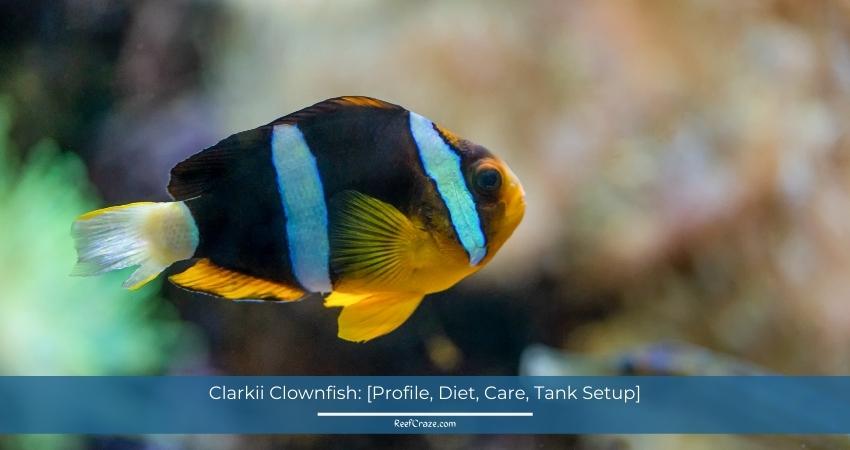
Yellowtail Clown, a Clarkii Complex Clownfish, has a massive physique. Roundly shaped with a sturdy body, it has a curly tail allowing it to swim more swiftly than a round-tailed anemonefish.
Growing into an adult, it takes on an array of colors. Adults show 2-3 types of broad and vertical stripes ranging from white to grey with a yellow to brown basal color. They often lack tail bands. You can locate a single band behind their eyes, three near the tail segment’s base, and another after their anal feathers.
Colors of Clarkii Clownfish
Depending on its origin, a Clarkii Clownfish has 8 color variations. Each has the same pair of vertical white marks as adults, but the tail fin colors vary between pale yellow and a combination below.
- It has a brownish-to-black body with a white throat, a white tail fin, and orange gills, chest, lateral fins, eyes, and mouth to signify the Indo-Pacific variant. Sometimes the tail can be entirely yellow or yellow bordering white.
- Another type has a wholly black body with a white to dull yellow tail tipped white and a white snout.
- Sometimes, you will also recognize a dark-bodied and a white-nosed Clarkii. It has a yellow tail segment with white at its lower region and yellow edges on its dorsal fins.
- There is a Japanese variation too. The easiest way to identify it is its distinct purple color. It has black in its head and above its eyes while the color changes to yellow or orange below them, like the breast, belly, gill, jaw, and dorsal fins. The tail and anal fins are also yellow.
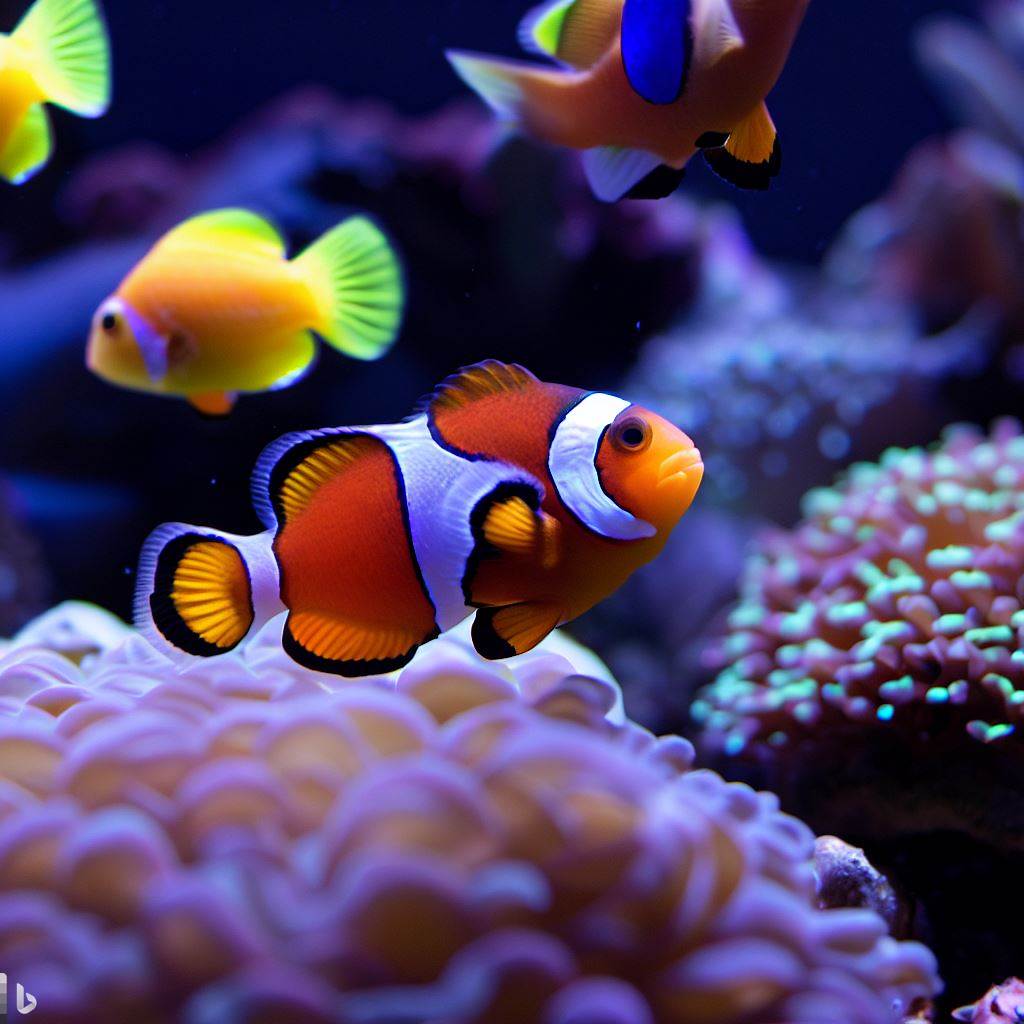
Gender, Length, And Lifespan of Clarkii Clownfish
The tail fins will be entirely or partly yellow if male. A female’s tail may become white as it ages. A juvenile has a pair of white body stripes in its body with a touch of reddish brown. The color of its nose is yellow.
A Clarkii can grow up to 14 cm or 5.5 inches, longer than an average Clownfish of 4.3 inches. It lives for around 13 years in the wild. But when captivated and maintained well, its lifespan extends to 14 years.
Diet And Feeding
Sea Bees are omnivores. They live on benthic algae, polychaete worms, zooplankton, and weeds in their natural habitats. They will eat different types of flake, frozen, and live foods while consuming naturally grown algae in the aquarium.
It is essential to feed your Clown a combination of frozen and fresh meaty foods, which should make up for the larger part of its diet. Healthy and nutritious foods include finely chopped shrimp and fish.
Furthermore, you should keep veggies in flake and pellet forms in the diet. Feed 3 or 4 times every day when they are juveniles. Turn it down to twice when they grow into adults. The tank should have a region with mild water movements to allow them to eat comfortably.
Tank Setup For Clarkii Clownfish
You cannot keep your Clarkii in a nano tank. It has to be bigger than that. While any substrate type is okay, you have to pay attention to the other stuff, like lighting and decoration, as follows.
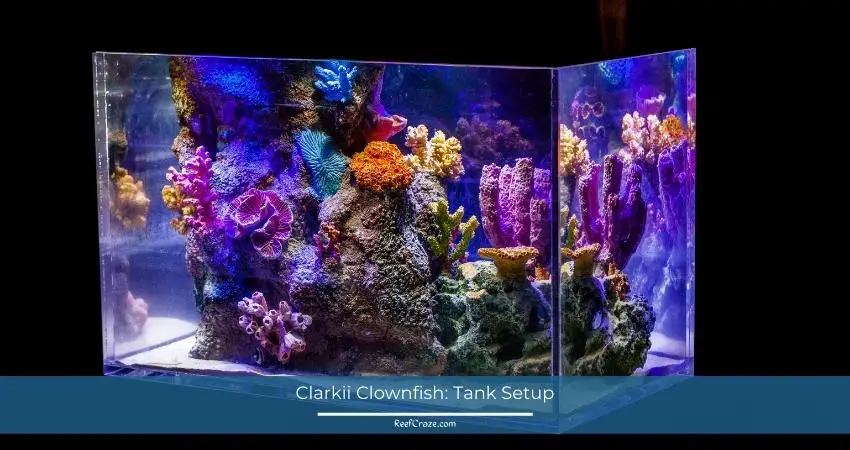
Size
It is an active and sizable fish, demanding a 30-gallon tank at the minimum for a single one. But a 40- or 50-gallon is much better. The size will get bigger per the number of fish, for example, a 55-gallon+ for two.
Decoration Requirements
Decorate the aquarium with hiding places and live rocks if you have no anemone. Swimming in clear water movement is difficult for Clarkii.
Now, what if you have a fish that demands unobstructed movements in the water? Give it the space towards the tank’s back to prevent your Clownfish from getting blown away. When used to its residence, it will learn to resurface during its meal times.
Lighting
Lighting is not an issue for Clarkii. But it will become one if your tank houses an anemone, as it needs heavy lighting arrangements.
Besides, the aquarium size should be spacious enough to meet the anemone’s requirements. Also, it should be 6 to 12 months old. It will spend most of its life with its host but swim in all areas of the tank, too. So you must give them open space to swim freely.
Water Parameters
| Parameter | Recommended Level For FO And FOWLR | Recommended Level For Reef Tanks |
| Ammonia (NH3) | Untraceable | Untraceable |
| Nitrite (NO2) | Untraceable | Untraceable |
| pH | 8.1 to 8.4 | Same |
| Strontium | 4 to 10 ppm | 8-14 ppm |
| Alkalinity | 8 to 12 dKH | Same |
| Temperature | 72 to 78°F | Same |
| Calcium | 350 to 450 ppm | Same |
| Magnesium | 1150 to 1350 ppm | 1250 to 1350 ppm |
| Specific Gravity | 1.020 to 1.025 | 1.023 to 1.025 |
| Iodine | 0.04 to 0.10 ppm | 0.06 to 0.10 ppm |
| Nitrate – Nitrogen (NO3) | < 30.0 ppm | < 1.0 ppm |
| Phosphate (PO4) | < 1.0 ppm | < 0.2 ppm |
Water Changes
The smaller your tank size is, the more frequent water change it will need. That is because the water condition deteriorates quicker in a small tank.
The standard maintenance requires a 15% water change twice a month or a 30% once a month. Depending on your tank size, a tank with corals needs a weekly 5% to a bi-monthly 15% water change.
As Clarkii Clownfish can suit itself in suboptimal water quality, it often discourages aquarists from regularly taking care of the tank water. But remember that its continuation can cause your fish to catch diseases.
Breeding of Clarkii Clownfish
Although people breed the Yellowtail Anemonefish in captivity, its breeding characteristics differ from other Clownfish. They partner with their mates like their fellows but have a reputation for not maintaining loyalty. When at close distance, males mate with different females.
The other peculiarity is that they can change their genders. Additionally, you may also notice a team of 3 Clowns breed and protect their eggs together, a couple of females with an overworked male instead of a typical couple.
If you desire to have Clown babies soon, keep the parents properly fed with enough calories and nutrition. You must supply them healthy diet several times per day. Try live foods, too, as they are more nutritious than canned foods.
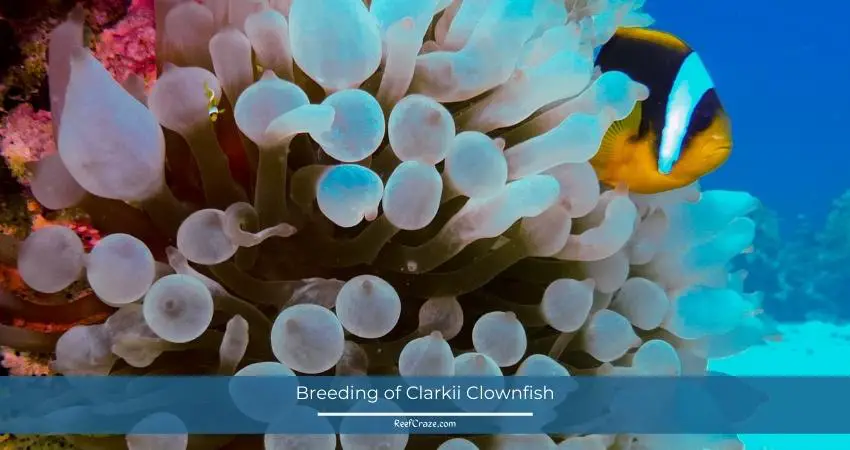
Be prepared that it will not be easy to breed Clarkii Clownfish. But it is, of course, achievable if you are persistent and caring. Reproducing the ones grown in aquariums is less complex than the wild ones. Keep the water temperature between 79 and 83 degrees Fahrenheit to get the best quality Clown eggs with larvae.
Point to take – while a Clarkii can alter its sex, it is born genderless. It turns into an adolescent male responding to particular social cues. Then when it is time, it becomes a female.
It is fascinating to see the behavior differences among Clownfishes. A female’s constant dominance often deters a male from transforming sex. A submissive Clown shows appeaser behavior, while a dominant one appears agonistic.
However, interestingly enough, each Clownfish possesses a unique personality. It has been noticed to drift away from its host anemone further from its other family members.
Spawning
Pairing Clarkiis is a big deal to the extent that a female can cause the death of a male if she is reluctant to accept him as a potential partner. It is wise to take care of some juveniles and allow them to choose their partners by themselves. Then, once they do that, you should separate them from the others in the aquarium.
Moreover, consider the possibility that maintaining both the male and female Clowns in a single space can make them hostile to each other and become threatening.
When the matching is complete, feed them with lots of fresh and high-quality food. Since Clarkii is a substrate breeder, it prefers to lay its eggs in caves or solid surfaces like upturned clay pots. As a result, it becomes easier as you will not need sea anemones to spawn.
Clarkii Clownfish Behavior
Clarkii Clownfish is semi-aggressive, being one of the most aggressive among its family. Despite its usual peaceful nature, it shows aggression when injured or scared.
Leave it alone and give them enough space because it becomes attacking any swimmer in the proximity of its beak and uses it as a spear.
Apart from that, it also becomes aggressive if the tank water is too murky. So let it stay isolated in peace during that time.
Suitable Tank Mates For Clarkii Clownfish
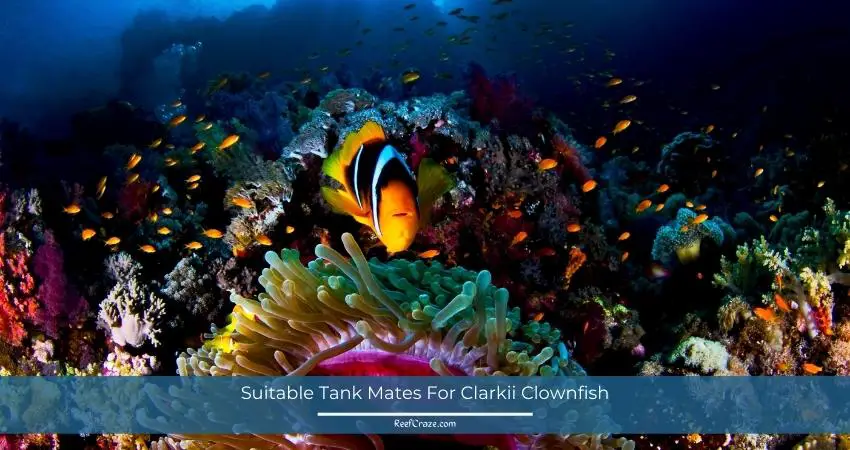
You can keep them in a fish-only setting or a reef system. As they mature, they tend to get macho and territorial, like Damselfishes. Once a grown pair establishes a bond, they attack any Clown pairs and harass peaceful Damselfishes.
Nonetheless, though gentle-natured fish can get bullied by them, many tank mates are suitable for Clarkiis. You can think of having bigger-sized semi-aggressive fish if you keep your Clown with a sea anemone. However, make it the first to get introduced to the tank environment before adding large Perches, Triggers, Angelfishes, and others.
Some fishes that make suitable tank mates for Clarkii Clownfish are Darfish, Butterflyfish, Blenny, Mandarin Dragonet, Pseudochromis, Banggai Cardinalfish, Red Coris Wrasse, Basslets, Pygmy Angelfish, Chromis, Yellow Tang, and others.
Never put Dottybacks with Clarkiis. Predatory fish capable of swallowing them is also not an option.
Host Anemones For Clarkii Clownfish
The species is compatible with 10 various sea anemones, including Bubble Tip (Entacmaea quadricolor), Sebae (Heteractis crispa), Giant Carpet (Stichodactyla gigantea), Beaded Sea (Heteractis aurora), Saddle (Stichodactyla haddoni), Merten’s Carpet (Stitchdactyla mertensi), Long Tentacle (Macrodactyla doreensis), Delicate (Heteractis malu), Magnificent/Ritteri (Heteractis magnifica), and Adhesive Sea Anemones (Cryptodendrum adhaesivum).
Pick any mentioned hosts and avoid Condy Anemones (Condylactis gigantea). They are mobile, hostile, and not Clownfish-friendly.
They have a severer sting than that of general clown-hosting Sea Anemones. Besides, if a dumb one engages itself, it may end up getting eaten by the Condy. You do not want to keep your Clowns at that risk.
Are Clarkii Clownfish Reef Safe?
Clarkii Clownfish blends in just fine in a reef setting, particularly if it has a host Sea Anemone. It will not disturb any corals unless it adopts them as its host. Then it will pick at the algae on the coral’s base.
Although Sea Anemones make a fine addition to a reef tank, many reefers rethink having them because of their demanding maintenance. But you can do without having them, as a Clarkii can live and flourish without them. It can adopt Large Polyp Stony (LPS) Corals or Soft Coral as its substitute hosts. Hairy Mushrooms are also its favorite surrogate.
When the host is not a Sea Anemone, see that the Clarkii does not irritate it so much that it refuses to open or starts starving.
There is something about the Giant Cup Mushroom or Elephant Ear Mushroom (Amplexidiscus fenestrafer) being a Clownfish host. It often traps and eats juvie Clowns, which asks for the tank owner’s supervision. But the adult ones are quite safe.
As long as there are inverts in the tank, they will not face danger from a Clark’s Anemonefish except a snail, crab, or non-cleaning shrimp (i.e., Marbled Shrimp and Pistol Shrimp).
You can also have Clams, Oysters, Scallops, Bristle Worms, Feather Dusters, Flatworms, Mini Brittle Stars, Copepods, and Amphipods in your tank. They will be under no harm from a Yellowtail.
Difficulty Of Keeping Clarkii Clownfish
It is easy to maintain Clarkiis. Plus, their being hardy also helps a great deal for a beginning reefer.
The only thing to ensure when buying a Clarkii is that it is healthy and eats adequately. During purchase, avoid if it has excessive white mucus or slime casting on its back. Tiny white patches on its gills, fins, and skin are Crypt symptoms. Look for a fresh and active one instead.
Availability
Clarkiis are always available in pet shops and online stores at a modest price. The ones bred in captivity, like Spotted Clark’s Clownfish, Picasso Clark’s Clownfish, and Galaxy Clarkii Clownfish, might be expensive compared to regular Clarkii because of their eccentric appearance.
Predation
It is a crucial reason for death for most Clownfishes. They often fall prey to predators like Octopuses, Barracudas, Groupers, Soapfishes, and Lionfishes. Large Wrasses and Angelfishes are also threatening.
Even if you do keep some of them in your tank to coexist with your Clownfish, monitor them strictly.
Diseases
Sebae Clownfishes are generally very hardy. So you do not have to worry about their diseases if you have a well-maintained tank. They do not get sick now and then, but when they do, it can get deadly.
They are vulnerable to parasitic, fungal, and bacterial diseases and injuries. Every saltwater fish gets sick due to poor water quality, temperature fluctuations, and stress caused by hostile tank mates. When stressed, a fish has a higher chance of catching a disease than an active one.
Clarkiis are specifically susceptible to Clownfish Disease Brook (Brooklynella hostilis) or Brooklynellosis, Uronema Disease (Uronema marinum), Marine Ich (Cryptocaryon irritans) or Crypt or White Spot Disease, and Velvet or Marine Velvet Disease (Oodinium ocellatum, Amyloodinium ocellatum, or Branchiophilus Maris).
Crypt is the most easily curable disease, but you need to identify it in time. Velvet, a parasitic skin flagellate, is a commonly experienced malady in marine aquariums. The fast-spreading disease initially infects Clarkii’s gills.
Brook is a fast killer, taking approx 30 hours to do its thing, but Uronema is more advanced. A Clownfish suffering from Uronema will be dead overnight. It often occurs when the reefer lowers the tank’s salinity to nurse another disease but does not sufficiently lower it. The parasite burgeons in medium brackish salinity with a gravity range of 1.013 to 1.020.
Always keep the salinity level at a normal gravity of 1.023 or a lower one of 1.009 to treat a disease. While medicines will work effectively in both ranges, the lower one can do better with the tank’s oxygen level.
Oxygen increases with the reduction of salinity. So, when you notch it down, it helps your Clownfish breathe easily without much stress.
Whenever you add anything not quarantined or cleaned properly to your aquarium, it can introduce diseases. That includes fish, corals, and live rock. The most effective way to prevent that is to clean them as best as possible before bringing them inside.
The secondary steps to prevent diseases are providing nutrition-rich foods, maintaining water quality, and keeping friendly tank mates.
Final Words
All in all, I can safely conclude that keeping a Clarkii Clownfish in a home aquarium is a manageable head start for new aquarists. The tank arrangement, necessary equipment, and water parameters are easy to maintain.
But easy does not mean effortless. It is mandatory to educate yourself about all the stuff. For example, feeding Yellowtails requires knowledge and practice. They will physically suffer if they cannot eat per their needs.
You should also choose the tank mates carefully. So they do not become victims of other pets and vice versa. If you can abide by these basic rules, your Clarkiis will live a healthy and happy life without any issues.
